
Harpers Ferry is a historic town in Jefferson County, West Virginia, United States, in the lower Shenandoah Valley. The population was 285 at the 2020 census. Situated at the confluence of the Potomac and Shenandoah rivers, where the U.S. states of Maryland, Virginia, and West Virginia meet, it is the easternmost town in West Virginia.

Washington Crossing State Park is a 3,575-acre (14 km2) New Jersey state park that is part of Washington's Crossing, a U.S. National Historic Landmark area. It is located in the Washington Crossing and Titusville sections of Hopewell Township in Mercer County, north of Trenton along the Delaware River. The park is operated and maintained by the New Jersey Division of Parks and Forestry. It is supported by the Washington Crossing Park Association, a friends group that works to preserve, enhance, and advocate for the park.

The Sloan–Parker House, also known as the Stone House, Parker Family Residence, or Richard Sloan House, is a late-18th-century stone residence near Junction, Hampshire County, in the U.S. state of West Virginia. It was built on land vacated by the Shawnee after the Native American nation had been violently forced to move west to Kansas following their defeat at the Battle of Point Pleasant in 1774. The building was added to the National Register of Historic Places on June 5, 1975, becoming Hampshire County's first property to be listed on the register. The Sloan–Parker House has been in the Parker family since 1854. The house and its adjacent farm are located along the Northwestern Turnpike in the rural Mill Creek valley.
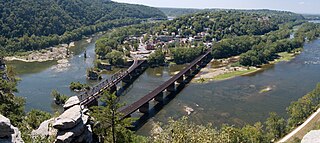
Harpers Ferry National Historical Park, originally Harpers Ferry National Monument, is located at the confluence of the Potomac and Shenandoah rivers in and around Harpers Ferry, West Virginia. The park includes the historic center of Harpers Ferry, notable as a key 19th-century industrial area and as the scene of John Brown's failed abolitionist uprising. It contains the most visited historic site in the state of West Virginia, John Brown's Fort.

John Brown's Fort was initially built in 1848 for use as a guard and fire engine house by the federal Harpers Ferry Armory, in Harpers Ferry, Virginia. An 1848 military report described the building as "An engine and guard-house 35 1/2 x 24 feet, one story brick, covered with slate, and having copper gutters and down spouts…"
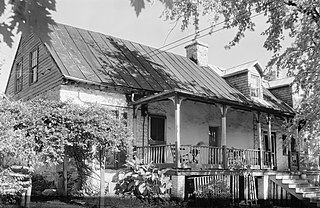
White House Farm, also known as White House Tavern and the Dr. John McCormick House, listed in the National Register of Historic Places, is located in Jefferson County, West Virginia, near the small town of Summit Point, about six miles from Charles Town, West Virginia. The farm consists of a ca. 1740 farmhouse, a stone barn, a springhouse of about the same age, a wooden curing shed, and 60+ acres of pasture and woods. The farm is one of the oldest in the county and has a rich history.

Long Grass Plantation is a historic house and national historic district located along what was the Roanoke River basin. In the 1950s most of it was flooded and became the Buggs Island Lake/John H. Kerr Reservoir in Mecklenburg County, Virginia. The house was built circa 1800 by George Tarry on land belonging to his father, Samuel Tarry, and Long Grass Plantation encompassed approximately 2000 acres (8 km2).
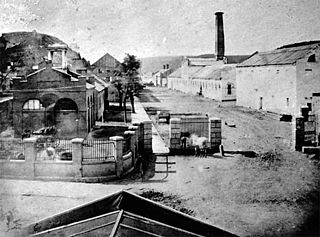
The Harpers Ferry Armory, more formally known as the United States Armory and Arsenal at Harpers Ferry, was the second federal armory created by the United States government; the first was the Springfield Armory. It was located in Harpers Ferry, Virginia, which since 1863 has been part of West Virginia. It was both an arsenal, manufacturing firearms, and an armory, a storehouse for firearms. Along with the Springfield Armory, it was instrumental in the development of machining techniques to make interchangeable parts of precisely the same dimensions.

The Stone House Inn, also known as the David Sisson House, located at 122 Sakonnet Point Road in Little Compton, Rhode Island, is a large four-story fieldstone residence – built in 1854 for David Sisson, a Providence-based industrialist – and its associated c.1886 barn. The structures sit on 2 acres of land overlooking Round Pond to the south, with a view of the Sakonnet River and Sakonnet Harbor to the west. When the house was completed, it was the largest single-family dwelling in that region and the only one built of stone.

The Kennedy Farm is a National Historic Landmark property on Chestnut Grove Road in rural southern Washington County, Maryland. It is notable as the place where the radical abolitionist John Brown planned and began his raid on Harpers Ferry, Virginia, in 1859. Also known as the John Brown Raid Headquarters and Kennedy Farmhouse, the log, stone, and brick building has been restored to its appearance at the time of the raid. The farm is now owned by a preservation nonprofit.

Altona, near Charles Town, West Virginia, is a historic farm with an extensive set of subsidiary buildings. The original Federal style plantation house was built in 1793 by Revolutionary War officer Abraham Davenport on land purchased from Charles Washington. The house was expanded by Abraham's son, Colonel Braxton Davenport. During the Civil War the farm was a favored encampment. Generals Philip Sheridan and Ulysses S. Grant both used the house as a headquarters and meeting place.
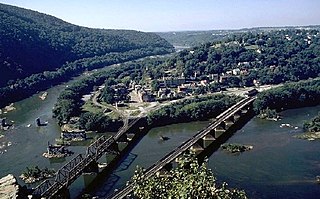
The B & O Railroad Potomac River Crossing is a 15-acre (6.1 ha) historic site where a set of railroad bridges, originally built by the Baltimore and Ohio Railroad, span the Potomac River between Sandy Hook, Maryland and Harpers Ferry, West Virginia. The site was added to the National Register of Historic Places on February 14, 1978, for its significance in commerce, engineering, industry, invention, and transportation.
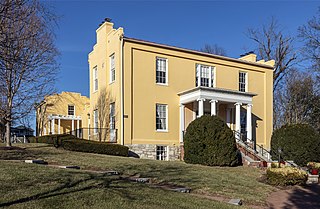
Beall-Air, also known as the Colonel Lewis William Washington House, is a two-story stuccoed brick house in classical revival style near Halltown, West Virginia. It was the home of Colonel Lewis William Washington, great-great nephew of President George Washington and hostage in John Brown's raid on Harpers Ferry, West Virginia.

The Harpers Ferry Historic District comprises about one hundred historic structures in Harpers Ferry, West Virginia. The historic district includes the portions of the central town not included in Harpers Ferry National Historical Park, including large numbers of early 19th-century houses built by the United States Government for the workers at the Harpers Ferry Armory. Significant buildings and sites include the site of the Armory, the U.S Armory Potomac Canal, the Harpers Ferry Train Station, and Shenandoah Street, Potomac Street, and High or Washington Street. The National Historic Park essentially comprises the lower, flood-prone areas of the town, while the Historic District comprises the upper town.

John Brown's raid on Harpers Ferry was an effort by abolitionist John Brown, from October 16 to 18, 1859, to initiate a slave revolt in Southern states by taking over the United States arsenal at Harpers Ferry, Virginia. It has been called the dress rehearsal for, or tragic prelude to, the Civil War.

The Clover Hill Tavern with its guest house and slave quarters are structures within the Appomattox Court House National Historical Park. They were registered in the National Park Service's database of Official Structures on October 15, 1966.

Lewis William Washington was an American planter and great-grandnephew of President George Washington. He is most remembered today for his involuntary participation in John Brown's raid on Harpers Ferry, Virginia, in 1859. He was taken as hostage and some of his slaves were briefly freed. As he outranked the other hostages he was their unofficial spokesperson, and he testified in Brown's subsequent trial, and before the Senate committee investigating the raid.

The McNeil Homestead is a historic ferry-related property off Wings Point Road in Charlotte, Vermont, USA. The complex includes a 19th-century house, former tavern, and barn, all built by members of the McNeil family, the first operators of the Charlotte-Essex Ferry, whose eastern terminus is just south of the property. It was listed on the National Register of Historic Places in 1982.
The Heyward Shepherd monument is a monument in Harpers Ferry, West Virginia, constructed in 1931. It commemorates Heyward Shepherd, a free black man, who was the first person killed during John Brown's raid on Harpers Ferry. The monument was constructed to promote the pseudo-historical Lost Cause of the Confederacy myth, by falsely claiming that Shepherd was opposed to freeing the slaves.
On Sunday night, October 16, 1859, the abolitionist John Brown led a motley band of 22 in a raid on the federal arsenal at Harpers Ferry, Virginia. Most were much younger than him, and varied dramatically in social class and education. "It would be hard to find again such a strange party as that which upheld John Brown in his daring expedition."





















